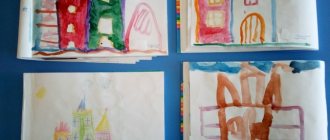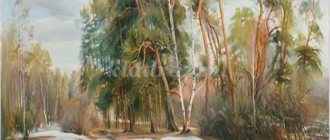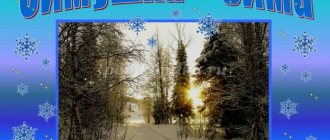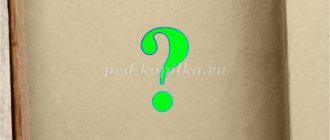Summary of a lesson on environmental education in the preparatory group
Abstract of the NOOD on environmental education for children of the preparatory school group “We take care of our health, we live in a clean city”
Compiled and conducted by teacher Ekaterina Nikolaevna Ivanova, first qualification category Purpose: To clarify children’s ideas about the sources of waste and to introduce them to the principles of collection and disposal of household waste. Objectives: 1. To formulate the need for cleanliness on the streets of the city, at home, in kindergarten. 2. To develop the ability to sort garbage when collecting it. 3. To promote the development of the ability to differentiate objects by the material from which they were made. 4. Develop the ability to analyze an environmental problem. 5. Foster a caring attitude towards the environment. Methods: Practical, game, visual, verbal. Techniques: Immersion in a game situation, explanation, conversation, use of literary words, showing illustrations. Integration of educational areas: “Cognitive development”, “Socio-communicative development”, “Physical development”, “Speech development”, “Artistic and aesthetic development”. Types of children's activities: communicative, gaming, cognitive and research. Form of work: subgroup. Technologies used: Gaming Awakening interest in activities. Development of communication skills. TRIZ teaches children to search for and find their own solution, find a way out of a difficult situation, and help others look at a problem from a different angle. Cooperation Realizes democracy, equality, partnership in the subjective relations of the teacher and the child. Organization of the educational environment: garbage containers, various packaging (for the d/game “Sorting Garbage Correctly”)
, didactic game “How Waste Appears”, blanks for crafts
(colored smiley face printed on photo paper - the face of the Sun, a ring made of cardboard, a thin wooden stick, strips from bags)
.
Progress of activities
Organizational moment. Educator: Guys, I’m very glad to see you all. Let's stand in a circle, greet each other, and get to know each other better. All around I see all my friends standing up. We will now go to the right, and now we will go to the left. We will gather in the center of the circle, and we will all return to our place. Let's smile, wink and say hello! Hello guys! My name is Ekaterina Nikolaevna! I came to you from another kindergarten. She told me that there are very good and smart children in your kindergarten. And I really wanted to get to know you better and communicate. Shall we get acquainted? What is your name? (Children say their names)
Guys, I didn’t come alone, but with guests.
Let's say hello to them, go up to them and touch their palms with our palms. Are your guests' palms warm? Because they are kind and shared their warmth with us. Highlight. Educator: Guys, today I had an unusual and strange dream. And I would like to tell you about it. Listen. (SLIDE No. 2)
- There lived a boy Petya, in a small town called Soligalich.
The city was clean and beautiful. Petya loved to go to the forest and breathe fresh air. But then one day he woke up, went out into the street, and saw garbage all around, and people were already drowning in garbage. The boy got scared, decided to hide in the forest from such horror, he came running and did not recognize his forest, there was garbage all around: papers, glass, cans. (SLIDE No. 3)
I came to the river and looked like the river was clean.
I decided to catch fish. He cast his fishing rod and feels that - that is! Pulled it out! And he pulled out a tin can. He sighed and put the jar next to him. I cast my fishing rod again. The second time he pulled out a torn shoe. Petya became completely sad. And he cast his fishing rod for the last time. Suddenly he feels that someone is pulling a hook into the depths. I pulled it out and couldn’t believe my eyes. - Who do you think fell for his bait? (Children's reasoning)
.
He looks and there is a Goldfish in front of him! And in a human voice he says to him: “Let me go into the river, good man, and I will fulfill your wishes!” - Okay, please fulfill my one and only wish and I will let you go. - Guys, what wish do you think the boy Petya asked to fulfill? (Children's assumptions)
.
- Do this, Goldfish, so that you don’t come across cans in the river instead of fish. And so that all the garbage disappears. And the Golden Fish answered him: how cunning you are! You scatter the garbage yourself, and I clean it up? Protect yourself from garbage. She waved her tail and slipped out of Petya’s hands. Educator: Strange dream, huh? Guys, do you also throw trash everywhere? What do you think Petya began to do? Children's answers. Educator: Do you know how to collect garbage? Let's check. Physical exercise. “We are walking down the street” (children together with the teacher imitate the movements)
: We are walking around the city, we will clean everything up together, we collect and put away glass and pieces of paper.
Once in the bucket, and twice in the basket, we tilt the back together. If you work together, everything around you will be transformed! Educator: Well done, you did a good job. Guys, today while I was walking towards you, I tripped over this bag with some items. Let's look at them. (I pour it out of the bag onto the floor)
- What is this?
Children's answers. Educator: That's right, it's trash. Has my dream begun to come true? Where did this garbage come from? Children's answers: Educator: Each person on our planet throws out approximately a ton of garbage per year - a full truck bed. (SLIDE No. 4)
There are several billion inhabitants on the planet.
Can you imagine how much garbage accumulates on the ground? Probably, soon humanity will have to save itself from garbage. After all, all this does not disappear without a trace, it all accumulates and pollutes our planet. What do we do? Children's answers . Educator: Guys, do you know how waste is created from the gifts of nature. Let's try to build a sequence. Let's divide into teams. Look at your badges and find a pair based on color. Didactic game “How waste is generated” Children must arrange them in a certain sequence: what happened before and what will happen next. For example: oil production, plastic production, a product in a plastic bottle, a person buys water in a plastic bottle, a crumpled bottle. 1. tree, cut down tree, paper production, newspaper, crumpled paper in the trash bin; 2. linen, thread, fabric, shirt, rag; 3. grain, sprout, apple tree, a person eats an apple, an apple core; 4. oil production, plastic production, goods in a plastic bottle, a person buys water in a plastic bottle, a crumpled bottle; 5. construction material in the store, the beginning of construction, the middle of construction, completion of construction and construction waste in the trash can; Children's answers: (children's independent activity) Educator: Please tell us what you did. Children's answers: Educator: Guys, look, we have different types of waste. (SLIDE No. 5)
Do you know what they are called?
Children's answers: Educator: Industrial waste is construction waste. Household waste is the garbage that we leave behind every day. These are various food packaging, bottles, bags, candy wrappers, iron cans, food waste, paper or waste paper, glass, old clothes. Outdoor game “Sorting garbage correctly.” Educator: Garbage releases toxic substances, and this is dangerous to human health. What to do with the garbage, of which there is so much? Children's answers: Educator: Guys, what do you think, for the purity of the environment, what is the best way to deal with garbage: take it to a landfill, bury it, burn it, or send it to a waste processing plant? Why? Children's answers: To the factory, the air and soil are less polluted, and they can also make new material there. Educator: Correct. In special factories, household waste is recycled and used to create new things that people use again, which helps save the natural resources of our planet. But before throwing away the garbage, it is sorted depending on the material from which it is made. This makes it easier to process at the plant. (SLIDE No. 6,7,8,9)
- Let's clean our hall, collect all the garbage.
We put paper waste in the first container, plastic waste in the second, and glass in the third. And in the fourth container - very hazardous waste - batteries. — Guys, look, there is a lot of paper and plastic waste and it won’t all fit in the container, what are you going to do? Children's answers: Educator: Well done. Pressing, crushing and tearing is the right idea. To avoid injuring your hands, collect garbage with gloves. Let's protect our hands and wear special gloves. (children put on work gloves and collect garbage while listening to music) Educator: Look how clean and beautiful it is! Guys, we have already said today that some types of waste are reused. That is, it is recycled and used again. Let's look at the screen. What can we do with the garbage that we have sorted? (SLIDE No. 11,12,13) Educator: Would you like us to try to make something from the items that ended up in the trash bin. Let's go to the creative workshop "Trash Crafts". And we will make gifts for our guests. (children go to the creative workshop and make suns out of garbage bags) Reflection Educator: Our lesson has come to an end. Tell us what you did in class? What did you like best? What new things have you learned? Tell us what you can do for our land so that it always remains beautiful and clean? Children's answers: Educator: We all did a great job together. We understood that we need to protect, love and use wisely everything that the Earth gives us. Although you have not grown up yet, you can also help our Earth remain blue and clean with your small good deeds. And then my dream will never come true. Children's answers: Educator: Guys, let's give your sunshine to our guests? And say goodbye. (children give the guests their crafts and say goodbye to them)
Presentation on the topic: We take care of our health, we live in a clean city
We recommend watching:
Summary of joint activities in the preparatory group. Earth Day Synopsis of a lesson on ecology in a preparatory school group Synopsis of an educational lesson in a preparatory school group “Where do milk rivers flow from” Synopsis of the OOD “Red Book of the Moscow Region” with children of the preparatory group of a kindergarten
Similar articles:
Summary of a lesson on ecology in the preparatory group. Plants on the territory of the kindergarten
Summary of a lesson on ecology in the preparatory group. Garden plants
Summary of a lesson on ecology in the preparatory group. Vegetable garden plants
Summary of a comprehensive lesson on ecology in the preparatory group. Topic: “Simple and valuable stones in nature”
Abstract of GCD on ecology in kindergarten in the preparatory group. Protect nature - our common home
Abstract of GCD on ecology in the preparatory group.
Topic: “Protect nature - our common home” Goal : Expand children’s understanding of natural objects and phenomena, flora and fauna, the relationship between nature and humans. Educational objectives: - create conditions for the development of cognitive interest in the natural world; — define the concept of “ecologist”, give a clear formulation; — formation of initial skills and habits of environmentally literate behavior that is safe for nature and for the child himself; — developing the ability to express one’s thoughts clearly for others. Educational objectives: - create conditions for nurturing a humane, emotionally positive, careful, caring attitude towards the natural world and the environment as a whole. Developmental tasks: - create conditions for the development of imagination, attention, thinking, and holistic perception of objects. Preliminary work: Reading the encyclopedia “Why and Why?”, reading fiction by V. Bianki “The Adventure of an Ant,” holding a conversation “Forest and Man,” an exhibition of drawings “Nature through the eyes of a child,” selecting poems to read by heart, designing a corner of nature. Age group: preparatory group, duration of educational activities: 25-30 minutes. Materials and equipment: Tape recorder with flash card;
a globe with a box, an image of Aibolit, a poster “Children’s behavior in the forest,” cards “How you should not behave in the forest,” paper stones with numbers, an anthill, sweet prizes for children, a basket, a candle, a plate, cotton swabs, a mood screen. Contents of OD:
1. Organizational moment. - Hello guys! Guests came to our class today. I propose to greet everyone: Invented by someone simply and wisely When meeting, say hello: “Good morning!” Good morning to smiling faces! Good morning to the sun and birds! Let everyone become kind and trusting. May the good morning last until the evening! 2. Motivation for educational activities. - Guys, today we have a very interesting job ahead of us, and for this you need to listen well, be attentive and active. - Children, would you like to find a treasure? - And what is it? (children's answers) - Correct. But there are things on earth much more valuable than gold and money. They cannot be spent; over the years they become more and more numerous. This is knowledge. It is for this treasure that we will go today. Difficulties and dangers await us, but we will definitely cope with them, because the good doctor Aibolit has come to your aid. 3. Setting the topic of the lesson by children. - Guys, look, Aibolit has a big box in his hands. Before you open it, listen to the riddle, and we will understand what lies there: Our entire Earth fits on it: Seas, oceans, Forests and fields. And you will find the North Pole there too, And if you want, you can carry it in your hands (the globe). - Guys, what is a globe? (Globe is a model of the Earth). — A globe is a model of our planet Earth. The globe was invented and made by people. By looking at it, we can learn a lot about our planet: for example, what is the shape of the Earth? (It is round and looks like a ball). — What color is land marked on the globe? (Brown, light brown, yellow, green.) - Is there a lot of water on our planet? (More water than land). - What color is it indicated on the globe? (Water is indicated by blue, light blue, and white colors). — Children, Doctor Aibolit tells me that our planet Earth is the most beautiful of all the planets we know. Only on Earth there is life and all the diversity of nature that we see: the sky, the sun, the moon, stars, clouds, air, mountains, rivers, seas, grass, trees, fish, birds, animals. And of course, we must love, appreciate and cherish all this beauty, all the wealth of nature. Do you think we need to protect nature on our planet Earth? -Now, during our conversation, we highlighted the main words: protection, nature, planet Earth. What do you think we will talk about in class today? -That's right, guys, today I invite you to go to the natural world. The topic of our lesson, as you guessed correctly, is called: “Protect nature - our common home.” 4. Didactic game “Living and inanimate nature.” “This world is so diverse and unique. Let's remember what nature is? Now we will play the game “Living and Inanimate Nature”. (The teacher pronounces words related to living and inanimate nature, and the children clap their hands if they hear something related to living nature). 5. Resolving a problem situation. - Children, look at the illustration. The guys picked a large bouquet of flowers for the teacher, but he was not happy, but upset. - Why, do you think? (children answer) - Guys, how should you behave in nature? (Don’t make noise, don’t leave the fire unextinguished, don’t pick flowers, don’t break branches, don’t touch birds’ nests.) Well done guys. You love nature. To truly love nature you need to know the rules. 6. Game “Name the signs correctly.” “I’ll show you the signs, and you explain what they mean.” Children: - Do not break trees and bushes - trees purify the air - Do not make fires - a fire may break out and all living things die - Do not leave garbage so as not to litter nature - Do not pick flowers - flowers decorate nature, bees and butterflies need them - Do not catch butterflies - they are beautiful, like flowers, weightless and vulnerable - Do not destroy the nests of birds - they delight us with their songs - Do not take home baby animals - the forest is a home for them - Do not destroy anthills - they remove all carrion, sewage and take everything underground . Therefore, the forest is always clean and fresh. 7. Reading poems about protecting wildlife. - Guys, you named everything correctly, I suggest you sit down on the chairs. Children, you know that our good doctor Aibolit treats animals, helps bugs, bunnies, he loves nature very much and takes care of it. You, too, are all kind and caring, you know a lot of poems about protecting wildlife, come out and tell us: 1. You can’t act so cruelly! You can't harm trees. Let them grow in the forest - bring goodness and beauty! 2. Don't play with a fire in the forest. Be careful about it. Before you light it, make a hole for it. 3. But there were Cellophane jars, pieces of iron, and bottles left around. You can’t leave them here! Let’s not be captivated, friends: There’s garbage here in the forest, it’s a stranger. We’ll take it with us. 4. There is no need to pick flowers in vain! And there is no need to trample them If you pick a flower If it’s all: both me and you, If we pick flowers Then the trees and flowers will be empty And there will be no beauty. 5. For hedgehogs and squirrels, the Forest is their home. They live there boldly And in summer and winter They find food to raise Their children And they don’t want to leave the forest at all. 8. Physical education minute. To the music, children perform exercises together with the teacher. 9. Game Path. - Oh, trouble, trouble, trouble. The ant hole disappeared, Someone stepped on the anthill, Then he filled it up with stones! - Guys, let's help the ants, put stones on the path. (children take stones, look at them, there are numbers on them from 1 to 10) Children, you not only need to restore the path, but arrange the stones in order from 1 to 10. So that the ants find their way home. Can you handle it? -I'm so happy for you guys. You helped the ants restore their path. 10. Learning new things. - Guys, nature knows how to feel. We cry when we are offended. And nature also cries when it is offended. How can you offend her - environmental pollution. And when we help nature, protect it, take care of it, it rejoices. Yes, guys, there is such a profession - ecologist. I have a “Magic Basket of Ideas”, let’s try to fill it like you think environmentalists do. (children guess) - Guys, that’s right, the dictionary says that - Ecologists study the state of water, land, air, the influence of industrial waste on plants, animals and humans. They have great knowledge about the animal and plant world; in the event of environmental disasters, ecologists try to find the best way out of current situations; they can work in laboratories, plant trees, shrubs, flowers, care for them, and clean them. Environmentalists love nature, help it and protect it. — Guys, who are ecologists? — What do you guys think, the beauty of nature depends on man? — It depends, because people plant forests, protect animals, feed birds, clean rivers. What kind of air is there? (Children: dirty and clean.) Is the air always clean? Where can you find dirty air? — Plants and factories that discharge toxic substances onto the soil harm nature and human health. All this pollutes the air. (Teacher lights a candle) What do you see? Children : The candle is burning. — Can flames pollute the air? After all, we see nothing but flames. Children: No, it can’t. - We'll check now. I'll take a plate and hold it over the flame for a little while. What appeared at the bottom of the plate? Soot. Take a cotton swab and rub it over the stain. What color did she become? Children : Black. — We made sure that the smoke settled on the plate. This is how it is in nature: smoke settles on our houses, cars and trees. Where does the smoke come from? Children: fires, factory chimneys. — How to protect the air from smoke? Children : Install filters on factory pipes, change fuel in cars. “If factories and factories and cars smoke like this, our bright world will lose its strength and beauty. We won't see a rainbow or sunshine. Do you want this? - What planet would you like to live on? Children: beautiful, colorful. 11. Summary of the lesson, reflection. - Guys, let's remember what we talked about today? Now please tell me, did you like our lesson? Look, I have cards with emotions laid out on my table. Choose a card with the same emotion that you still have after our lesson and put it in the magic box. - Remember what I told you - knowledge is a treasure, and we definitely found this treasure today, you learned a lot of new things, worked well and actively. Doctor Aibolit and I have prepared gifts for you: new magazines for the ecology group and sweet prizes for good brain activity - chocolate medals. Thank you for your attention!
Related posts:
Environmental education of preschool children. From work experience Summary of GCD in the preparatory group on ecology Summer time in kindergarten Diagnostic map of the development of children in kindergarten
Similar articles:
Summary of a lesson on ecology in the preparatory group. What does ecology study?
Summary of a lesson on ecology in the preparatory group. Theme: Water
Summary of a lesson on ecology in the preparatory group. Topic: Soil
Summary of a lesson on ecology in the preparatory group. Flower garden plants
Summary of a lesson on ecology in the preparatory group on the topic “Algae, mosses, lichens, ferns”



